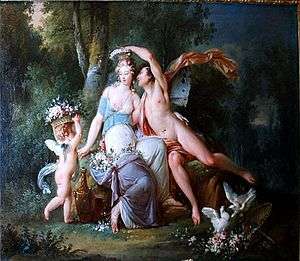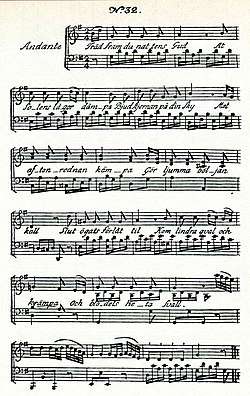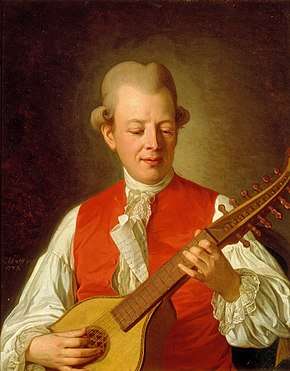Träd fram du Nattens Gud
"Träd fram du nattens gud" (Step forth, thou god of night), "Aftonkväde" (Song at Nightfall), or Fredmans sånger no. 32[1] is a nature-lyrical Swedish song by Carl Michael Bellman, a nocturne in the style of Edward Young's Night-Thoughts.[2]

Context
Carl Michael Bellman is the central figure in Swedish song, known for his 1790 Fredman's Epistles and his 1791 Fredman's Songs. He played the cittern, accompanying himself as he performed his songs at the royal court.[3]
Jean Fredman is a fictional character and the supposed narrator in Bellman's epistles and songs, based on a real watchmaker of Bellman's Stockholm.[4] The epistles paint a picture of the demimonde life of the city during the eighteenth century, where strong drink and beautiful "nymphs" like Ulla Winblad create a rococo picture of life, blending classical allusion and pastoral description with harsh reality.[3][4]
Song
"Aftonkväde" is included among Bellman's 1791 Fredman's songs as number 32; its first version was written in 1780, but it was reworked in 1784 prior to printing. From being a classicist depiction of an animated archaic landscape peopled by ancient gods, it contains more realistic details in the spirit of James Thomson. The verse size is similar to that used by Johan Gabriel Oxenstierna in his poem Night.[5] The poem first appeared in Bellman's 1780 En stuf rim, a collection of his earliest poems with some new compositions, like this one, imitating Oxenstierna, who in turn was following Edward Young's popular Night-Thoughts, published 1742–1745.[6] The poem has been translated by Paul Britten Austin. Verse 2 in his version and the original, with a prose translation, are compared in the table.
| Aftonkväde, 1791 Carl Michael Bellman | Prose translation | Song at Nightfall, 1967[6] Paul Britten Austin |
|---|---|---|
| Ditt täcke gömmer allt... Betraktom Floras gårdar! | Your quilt covers everything... Look at Flora's gardens! | All hid beneath thy cape, see Flora's gardens slumber; |
| Här skönsta höjder fly, där mörka griftevårdar | Here the most beautiful heights flee, there dark barrow-wights | Lo, fairest summits flee and ancient barrows sombre |
| på svarta kullar stå; | stand on black hills; | On sable hillocks low! |
| och under uvars gråt mullvadar, ormar, mårdar | and under owls' crying moles, snakes, and martens | Where weeps the hungry owl, moles, serpents without number |
| ur sina kamrar gå. | leave their chambers. | From out their chambers go. |

In terms of content, the poem combines a poetic integration of gods and other mythological beings, with a realistic, though idealized, depiction of a summer night after a long period of drought. Technically, it resembles several of Fredman's epistles, since the poet commands "the god of the night" to transform day to night and bring coolness to the world and the minds of the people, which are thus linked together. The nightly landscape, however, offers not only peace and rest, but threatening creatures - initially "moles, snakes, and martens", then cyclops, fauns and supernatural guests, who, however, are asked by the shepherd Alexis to lie down to rest. After he has similarly quieted the powers of the wind and the water, the poem's last stanza shows a typical ambiguity for Bellman, when Arachne is asked to trap his needle: is it a question of the myth or a poetic rewriting for the spider, related to the serpents and the martens? Regardless, the poem ends with another typical scene, with the announcement that the narrator is about to fall asleep, which certainly was meant to be depicted at the performance.[7]
The song is in 2
4 time and is marked Andante.[8] No source has been found for the elegant and neat melody, implying it may be Bellman's own composition; the metre is certainly Bellman's. Each stanza is of five lines, consisting of two alexandrines, a hemistich (half-length line), an alexandrine, and a final hemistich;[6] the rhyming scheme follows the same pattern, AABAB.[8]
The suggestion that the poem depicts the farm Sågtorp at Erstavik, based on its dedication to the assessor Weltzin, who had this farm as a summer residence, is doubtful.[5]
References
- Bellman, Carl Michael (1766). "N:o 32 Träd fram du nattens gud" (in Swedish). Retrieved 5 June 2019.
- "N:o 32" (in Swedish). Retrieved 5 June 2019.
- "The Life and Works of Carl Michael Bellman. A Short Biography". The Bellman Society. Archived from the original on 18 January 2015. Retrieved 15 January 2015.
- Britten Austin, 1967. Pages 61–93.
- Lönnroth, pages 225-226
- Britten Austin, pages 130–132
- Lönnroth, pages 226-228
- Hassler and Dahl, pages 213–217
Sources
- Britten Austin, Paul. The Life and Songs of Carl Michael Bellman: Genius of the Swedish Rococo. Allhem, Malmö American-Scandinavian Foundation, New York, 1967. ISBN 978-3-932759-00-0
- Britten Austin, Paul. Fredman's Epistles and Songs. Stockholm: Proprius, 1990 and 1999.
- Hassler, Göran; Peter Dahl (illus.) (1989). Bellman – en antologi [Bellman – an anthology]. En bok för alla. ISBN 91-7448-742-6.CS1 maint: multiple names: authors list (link)
- Kleveland, Åse; Svenolov Ehrén (illus.) (1984). Fredmans epistlar & sånger [The songs and epistles of Fredman]. Stockholm: Informationsförlaget. ISBN 91-7736-059-1.CS1 maint: multiple names: authors list (link) (with facsimiles of sheet music from first editions in 1790, 1791)
- Lönnroth, Lars (2005). Ljuva karneval!: om Carl Michael Bellmans diktning. Stockholm: Bonnier. ISBN 91-0-057245-4.
External links
- Träd fram, du nattens gud (full text)
